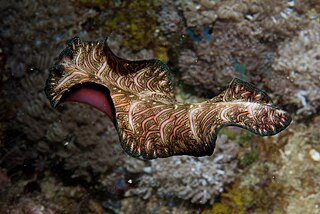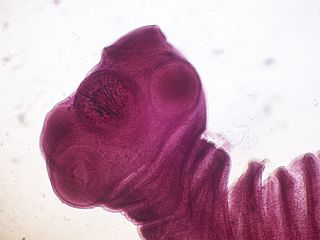Related Research Articles

The flatworms, flat worms, Platyhelminthes, or platyhelminths are a phylum of relatively simple bilaterian, unsegmented, soft-bodied invertebrates. Unlike other bilaterians, they are acoelomates, and have no specialised circulatory and respiratory organs, which restricts them to having flattened shapes that allow oxygen and nutrients to pass through their bodies by diffusion. The digestive cavity has only one opening for both ingestion and egestion ; as a result, the food cannot be processed continuously.

Microvilli are microscopic cellular membrane protrusions that increase the surface area for diffusion and minimize any increase in volume, and are involved in a wide variety of functions, including absorption, secretion, cellular adhesion, and mechanotransduction.

Trematoda is a class of flatworms known as flukes or trematodes. They are obligate internal parasites with a complex life cycle requiring at least two hosts. The intermediate host, in which asexual reproduction occurs, is usually a snail. The definitive host, where the flukes sexually reproduce, is a vertebrate. Infection by trematodes can cause disease in all five traditional vertebrate classes: mammals, birds, amphibians, reptiles, and fish.

Intestinal villi are small, finger-like projections that extend into the lumen of the small intestine. Each villus is approximately 0.5–1.6 mm in length, and has many microvilli projecting from the enterocytes of its epithelium which collectively form the striated or brush border. Each of these microvilli are about 1 µm in length, around 1000 times shorter than a single villus. The intestinal villi are much smaller than any of the circular folds in the intestine.

Digenea is a class of trematodes in the Platyhelminthes phylum, consisting of parasitic flatworms with a syncytial tegument and, usually, two suckers, one ventral and one oral. Adults commonly live within the digestive tract, but occur throughout the organ systems of all classes of vertebrates. Once thought to be related to the Monogenea, it is now recognised that they are closest to the Aspidogastrea and that the Monogenea are more closely allied with the Cestoda. Around 6,000 species have been described to date.

Fasciola hepatica, also known as the common liver fluke or sheep liver fluke, is a parasitic trematode of the class Trematoda, phylum Platyhelminthes. It infects the livers of various mammals, including humans, and is transmitted by sheep and cattle to humans the world over. The disease caused by the fluke is called fasciolosis or fascioliasis, which is a type of helminthiasis and has been classified as a neglected tropical disease. Fasciolosis is currently classified as a plant/food-borne trematode infection, often acquired through eating the parasite's metacercariae encysted on plants. F. hepatica, which is distributed worldwide, has been known as an important parasite of sheep and cattle for decades and causes significant economic losses in these livestock species, up to £23 million in the UK alone. Because of its relatively large size and economic importance, it has been the subject of many scientific investigations and may be the best-known of any trematode species. F. hepatica's closest relative is Fasciola gigantica. These two flukes are sister species; they share many morphological features and can mate with each other.

The Aspidogastrea is a small group of flukes comprising about 80 species. It is a subclass of the trematoda, and sister group to the Digenea. Species range in length from approximately one millimeter to several centimeters. They are parasites of freshwater and marine molluscs and vertebrates. Maturation may occur in the mollusc or vertebrate host. None of the species has any economic importance, but the group is of very great interest to biologists because it has several characters which appear to be archaic.

Taenia solium, the pork tapeworm, belongs to the cyclophyllid cestode family Taeniidae. It is found throughout the world and is most common in countries where pork is eaten. It is a tapeworm that uses humans as its definitive host and pigs as the intermediate or secondary hosts. It is transmitted to pigs through human feces that contain the parasite eggs and contaminate their fodder. Pigs ingest the eggs, which develop into larvae, then into oncospheres, and ultimately into infective tapeworm cysts, called cysticercus. Humans acquire the cysts through consumption of uncooked or under-cooked pork and the cysts grow into an adult worms in the small intestine.

Taenia saginata, commonly known as the beef tapeworm, is a zoonotic tapeworm belonging to the order Cyclophyllidea and genus Taenia. It is an intestinal parasite in humans causing taeniasis and cysticercosis in cattle. Cattle are the intermediate hosts, where larval development occurs, while humans are definitive hosts harbouring the adult worms. It is found globally and most prevalently where cattle are raised and beef is consumed. It is relatively common in Africa, Europe, Southeast Asia, South Asia, and Latin America. Humans are generally infected as a result of eating raw or undercooked beef which contains the infective larvae, called cysticerci. As hermaphrodites, each body segment called proglottid has complete sets of both male and female reproductive systems. Thus, reproduction is by self-fertilisation. From humans, embryonated eggs, called oncospheres, are released with faeces and are transmitted to cattle through contaminated fodder. Oncospheres develop inside muscle, liver, and lungs of cattle into infective cysticerci.
Dwarf tapeworm is a cosmopolitan species though most common in temperate zones, and is one of the most common cestodes infecting humans, especially children.

Eucestoda, commonly referred to as tapeworms, is the larger of the two subclasses of flatworms in the class Cestoda. Larvae have six posterior hooks on the scolex (head), in contrast to the ten-hooked Cestodaria. All tapeworms are endoparasites of vertebrates, living in the digestive tract or related ducts. Examples are the pork tapeworm with a human definitive host, and pigs as the secondary host, and Moniezia expansa, the definitive hosts of which are ruminants.

Hymenolepis is a genus of cyclophyllid tapeworms that cause hymenolepiasis. They parasitise mammals, including humans. Some notable species are:

Cestoda is a class of parasitic worms in the flatworm phylum (Platyhelminthes). Most of the species—and the best-known—are those in the subclass Eucestoda; they are ribbon-like worms as adults, known as tapeworms. Their bodies consist of many similar units known as proglottids—essentially packages of eggs which are regularly shed into the environment to infect other organisms. Species of the other subclass, Cestodaria, are mainly fish infecting parasites.
Diphyllobothrium mansonoides is a species of tapeworm (cestodes) that is endemic to North America. Infection with D. mansonoides in humans can result in sparganosis. Justus F. Mueller first reported this organism in 1935. D. mansonoides is similar to D. latum and Spirometra erinacei. When the organism was discovered, scientist did not know if D. mansonoides and S. erinacei were separate species. PCR analysis of the two worms has shown the two to be separate but closely related organisms.

Raillietina is a genus of tapeworms that includes helminth parasites of vertebrates, mostly of birds. The genus was named in 1920 in honour of a French veterinarian and helminthologist, Louis-Joseph Alcide Railliet. Of the 37 species recorded under the genus, Raillietina demerariensis, R. asiatica, and R. formsana are the only species reported from humans, while the rest are found in birds. R. echinobothrida, R. tetragona, and R. cesticillus are the most important species in terms of prevalence and pathogenicity among wild and domestic birds.

Raillietina echinobothrida is a parasitic tapeworm belonging to the class Cestoda. It is the most prevalent and pathogenic helminth parasite in birds, particularly in domestic fowl, Gallus domesticus Linnaeus, 1758. It requires two hosts, birds and ants, for completion of its life cycle. It is a hermaphrodite worm having both the male and female reproductive organs in its body. The parasite is responsible for 'nodular tapeworm disease' in poultry.
Tegument is a term in helminthology for the outer body covering of members of the phylum Platyhelminthes. The name is derived from a Latin word tegumentum or tegere, meaning "to cover". It is characteristic of flatworms including the broad groups of tapeworms and flukes. Once considered to be a non-living component, it is now known to be a dynamic cellular structure. In fact it is a living structure consisting of proteins, lipids, carbohydrates and RNA. It forms the protective layer and the host-parasite interface of the worms, serving both secretory and absorptive functions.

Flemingia vestita, famously known as sohphlang, is a nitrogen fixing herb with characteristic tuberous root, belonging to the genus Flemingia. The root is edible and is a common vegetable in some Asian tribal communities. In addition, it has been traditionally used as an anthelmintic, the basis of which is scientifically validated.

Rostellum in helminthology is a protruding part of the anterior end of tapeworms. It is a retractable, cone-like muscular structure that is located on the apical end of the scolex, and in most species is armed with hooks, the organs of attachment to the host's intestinal wall. It is a parasitic adaptation in some cestodes for firm attachment in the gastrointestinal tract and is structurally different from one species to another, thereby becoming an important diagnostic feature.
Glaridacris catostomi is a flatworm of the family Caryophyllaeidae. It is commonly found in freshwater environments of North America and is a known internal parasite of fishes of the family Catostomidae.
References
- ↑ Smyth JD, McManus DP (1989). The Physiology and Biochemistry of Cestodes . Academic Press, pp. 5-8. ISBN 0-521-35557-5
- ↑ Lumsden RD, Hildreth MB (1983). The fine structure of adult tapeworms. In: Biology of the Eucestoda Vol.1 (C Arme & PW Pappas, eds). Academic Press, New York, USA, pp. 177-233. ISBN 0-12-062101-0
- 1 2 Mansour TE, mansour JM (2002). Chemotherapeutic Targets in Parasites . Cambridge University Press, UK, pp. 192-297. ISBN 0-521-62065-1
- ↑ Chervy L. (2009). "Unified terminology for cestode microtriches: a proposal from the International Workshops on Cestode Systematics in 2002-2008". Folia Parasitol (Praha). 56 (3): 199–230. doi: 10.14411/fp.2009.025 . PMID 19827364.
- ↑ Venkatesh C, Ramalingam K, Vijayalakshmi V (2006). "Ultrastructure, differential density and distribution pattern of polymorphic microtriches in tegument of Stilesia globipunctata infecting Ovis aries (sheep)". J Parasit Dis. 30 (2): 68–75.
- ↑ Radha T, Satyaprema VA, Ramalingam K, Indumathi SP, Venkatesh C (2006). "Ultrastructure of polymorphic microtriches in the tegument of Raillietina echinobothrida that infects Gallus domesticus (fowl)". J Parasit Dis. 30 (2): 153–162.
- ↑ Cheng TC (1986). General Parasitology, 2nd edn. Academic Press, Division of Hardcourt Brace & Company, USA, pp. 253-2546. ISBN 0-12-170755-5
- ↑ Bogitsh BJ, Carter CE, Oeltman TN (2005). Human Parasitology, 3rd Edition . Academic Press, pp. 177-179. ISBN 0-12-088468-2
- ↑ Smyth JD, Halton DW (1983). The Physiology of Trematodes . Cambridge University Press, UK, pp. ISBN 0-521-22283-4